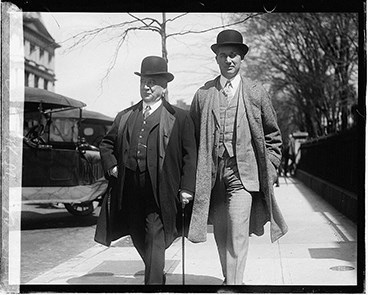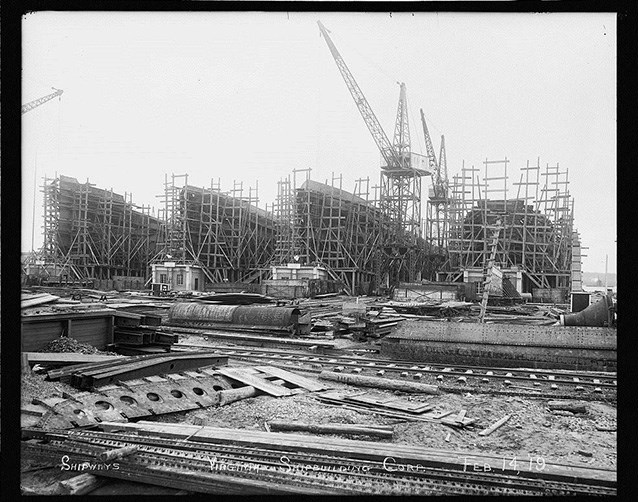Last updated: July 18, 2017
Article
Virginia Shipbuilding Corporation
When the United States entered World War I on April 6, 1917, the US Navy had already been engaged in a building program under the Naval Act of 1916. However, it was a peacetime Act. The wartime needs of a robust American merchant marine were a different matter, and this led to the rapid expansion of shipbuilding, particularly on the east coast.
"Never since George Washington made the river famous have large ships been constructed here."
Washington Times, DC 14 Jan 1919 p8

Library of Congress
On April 17, 1917, the United States Shipping Board created the Emergency Fleet Corporation, which was to oversee the program. Eventually under the direction of businessman Charles A. Schwab, the Corporation would increase American merchant tonnage from a production of only 250,000 tons per year to a fleet that measured over 9 million tons.
Existing shipyards could not handle the increase, however, so new, privately-owned shipyards rapidly sprang up, eager to take advantage of lucrative contracts with the Emergency Fleet Corporation. One of these yards was the Virginia Shipbuilding Corporation of Alexandria, Virginia. Built by shipping magnate and notorious financial scam artist Charles Wyman Morse of New York, the yard was a modern marvel. Construction began in early 1918, complete with a new rail spur, roads, and other infrastructure improvements to the city. Built on 47 acres of “made land” or infill, which had once been Battery Cove at Jones Point on the Potomac River, the yard boasted four large shipways.
The contract the Alexandria yard received was for twelve steel vessels of 9,400 tons each, the first 10 of which were to be launched in 1919. Eleven hundred men were at work at the yard by April 1918, and applications to work at the yard continued to pour in, at the rate of 50-60 a day. The yard anticipated needing up to 3,500 workers in order to complete the initial contract on time.
Understanding the stress that the influx of so many workers would have on the city, the yard engaged the community in a number of ways, including launching a slogan contest for the yard’s huge red, white, and blue sign with a prize of $10. Entries poured in from the citizens of Alexandria - from the stern admonition that “America Expects Every Man to Do His Duty,” (a nod to famous British Admiral Horatio Nelson) to the poetic “Each Boat We Float Gets Wilhelm’s Goat” to the simple “O U Boats!” But the winning entry belonged to Mrs. Isabel Fornshill of Queen Street in Alexandria – “More Tons, Less Huns.” Her slogan was painted on the eighteen by twenty foot illuminated sign that was visible from the water as well as the land.

Library of Congress
The yard laid the first keel on May 30, 1918 – the 85th working day after construction of the yard began. President Woodrow Wilson was on hand to drive the first rivet. Though he found the pneumatic hammer somewhat difficult to manage, the President was successful, quipping to one yard worker “I haven’t got my union card, but I guess it’s all right!” Mrs. Wilson then laid her hand on the keel and pronounced “I name thee Gunston Hall” – Gunston Hall being the nearby historic home of founding father George Mason.
As the Gunston Hall and other vessels were taking shape, however, the war was drawing to a close. News of the pending armistice with Germany reached the shipyard workers on the afternoon of November 7, 1918. As the city of Alexandria erupted in celebration, the shipyard whistles began blowing and shipyard bells rang for a full half hour. The managers of the shipyard gave the 1600 employees who were currently on site the rest of the day off in celebration. The launch of Gunston Hall was still three months away.
Though the plant was built for war, hopes were high for its continued operation in peace. The economic boom which the shipyard had brought to Alexandria was something that the city wished to see continue. Following the armistice with Germany on 11 November 1918, the local press began making statements concerning the permanence of the plant – noting that “…there are several years’ work ahead at the plant of the Virginia Shipbuilding Corporation, and proves that this big enterprise is a permanent institution for Alexandria.”
Though the ship was no longer needed for the war effort, the launch of the Gunston Hall was still a grand affair for the city, occurring the same day as returning troops paraded through the streets. Subsequent launches of eight additional vessels were equally celebrated. The US Shipping Board declared them “among the best afloat.” In mid-October 1919, the Evening Star of Washington DC reported that the Virginia Shipbuilding Corporation had acquired by purchase or lease all of the ships that it had built for the Emergency Fleet. The Corporation would pay the Emergency Fleet out of the net revenue gained from operating the vessels as cargo ships engaged in interstate commerce. This move, the article assured the reader, meant that “the uncertainty regarding the permanency of these yards at Alexandria is now dispelled,” and that “its future success is now assured.” Reorganized on a “peace basis,” it appeared that the 2000 men still employed by the corporation would retain their employment.
However, lawsuits and a Congressional inquiry into shipyard owner Charles W. Morse as early as 1920 revealed that monies meant for building the ships at Jones Point had been diverted to building the shipyard itself, as well as a housing project in which Morse and his associates had an interest – Rosemont in Alexandria.Under the shadow of investigation, the plant began laying off workers in the spring of 1920, and the yard was largely idled by early 1921.
On February 27, 1922, the Grand Jury of the District of Columbia returned indictments against Charles W. Morse, his three sons, and eight others, including Livingstone. They were charged with conspiracy to defraud the United States and the United States Shipping Board Emergency Fleet Corporation in connection with war contracts given to the United States Steamship Company and its subsidiary yards: Groton Iron Works in Connecticut, and the Virginia Shipbuilding Corporation.
The yard in Alexandria soon went into receivership, with much of the movable property auctioned off in the spring of 1922. Smaller businesses began renting the vacant buildings at the yard, and the government seized the nine vessels that the shipyard had ostensibly leased back from the government. Though Morse and his sons were eventually acquitted, and charges dropped for the other defendants, the damage to the shipyard had been done.
In an ironic twist, the property designed to build ships was leased in 1923 to the Western Marine and Salvage Company to dismantle surplus wooden vessels that existed following the end of the war. Fire and injuries plagued the operation, however, and the vessels themselves posed significant hazards to navigation and fishing along Alexandria’s waterfront. The company moved its operations to Mallows Bay, in Maryland, where they eventually abandoned the ships. The remains of the shipyard, now empty, became a haven for rum-runners and other lawbreakers. The buildings and remaining machinery and equipment of the Virginia Shipbuilding Corporation were sold at auction in mid-1928, and much of the yard was dismantled in the years following.
Today, little remains of the once bustling shipyard. The roar of D.C. metro traffic across the Woodrow Wilson Bridge has replaced the roar of shipyard industry, and runners, bicyclists, families, and tourists visiting Jones Point Park have replaced the thousands of workers. Yet for those inclined to look, there are still traces of the once mighty yard. Rails for the ways that launched the huge vessels remain, and a massive rudder stands silent vigil in the middle of the popular multi-use park, which is now a part of the George Washington Memorial Parkway.
